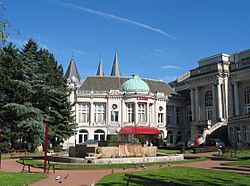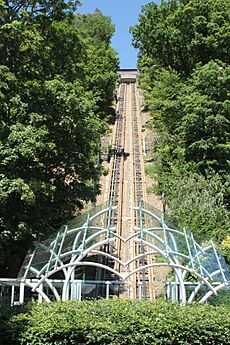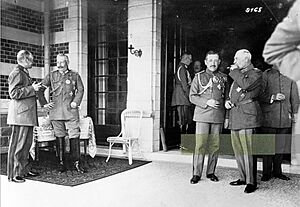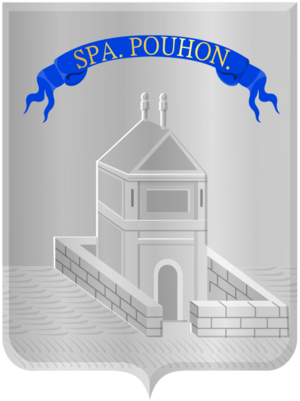Spa, Belgium facts for kids
Quick facts for kids
Spa
Spå (Walloon)
|
|||||||||||||
|---|---|---|---|---|---|---|---|---|---|---|---|---|---|

The Casino of Spa
|
|||||||||||||
|
|||||||||||||
| Country | Belgium | ||||||||||||
| Community | French Community | ||||||||||||
| Region | Wallonia | ||||||||||||
| Province | Liège | ||||||||||||
| Arrondissement | Verviers | ||||||||||||
| Area | |||||||||||||
| • Total | 39.85 km2 (15.39 sq mi) | ||||||||||||
| Population
(2018-01-01)Lua error in Module:Wd at line 1575: attempt to index field 'wikibase' (a nil value).
|
|||||||||||||
| • Total | Lua error in Module:Wd at line 1,575: attempt to index field 'wikibase' (a nil value). | ||||||||||||
| Postal codes |
4900
|
||||||||||||
| Area codes | 087 | ||||||||||||
| Website | www.villedespa.be | ||||||||||||
|
|||||||||||||
Spa is a famous city and municipality in Wallonia, Belgium. It is located in the province of Liège. The city's name became well-known around the world. Now, "spa" means a place with mineral baths that are thought to have healing powers.
Spa is in a valley within the Ardennes mountains. It is about 35 km (22 mi) southeast of Liège. In 2006, Spa had about 10,543 people. The city covers an area of 39.85 square kilometers (15.39 sq mi).
Spa is a very popular place for tourists in Belgium. It is famous for its natural mineral springs. The city also produces "Spa" mineral water, which is sold all over the world.
Near Spa, you'll find the motor-racing Circuit de Spa-Francorchamps. This track hosts the yearly Formula One Belgian Grand Prix. It also holds other long-distance races like the 24 Hours of Spa.
Spa was also home to the world's first beauty pageant. This event, called the Concours de Beauté, happened on September 19, 1888. The city also hosted a part of the Tour de France bicycle race in 2010.
In 2021, Spa became a UNESCO World Heritage Site. It is part of "The Great Spa Towns of Europe". This honor recognizes its famous mineral springs. It also highlights its beautiful buildings. These buildings show how European bathing culture grew in the 1700s and 1800s.
Contents
What Does "Spa" Mean?
The name Spa has a few possible origins. One idea is that it comes from the Latin word sparsa. This word means "scattered" and "gushing," like a spring. Another idea connects it to the Walloon word spâ, meaning "free space." This comes from the Latin spatia.
People have known about this place since Roman times. Back then, it was called Aquae Spadanae. Some people think "Spa" is a short form for Latin phrases. For example, salus per aquam or sanitas per aquam means "health through water." However, these are just made-up ideas that came later.
The word Spa has now become a general term. It refers to any place with natural water sources. These sources are believed to have special health benefits.
Spa's Story: A Look Back
Early History of Spa
Spa has been known for its cold springs since ancient times. These springs were believed to have healing powers. People came to "take the waters" even in classical antiquity. Pliny the Elder, a famous Roman writer, wrote about a spring in Gaul. He said its water could help the body and cure fevers.
The town of Spa grew during the Middle Ages. It was in an old iron and steel area of Liège Province. The area around Spa was set up around 1335. It included two main towns: Creppe and Spas. The steel industry helped build roads. These roads later helped the spa town grow.
In 1547, a doctor to King Henry VIII of England visited Spa. He helped spread the word about the value of Spa's water. In 1559, Gilbert Lymborh wrote about the "acid fountains of the Ardennes forest." His writings were translated into many languages.
In 1654, Prince Charles, who was later King of England, stayed in Spa. This made Spa even more famous. By 1699, a postal system connected Spa to other places.
Since the 1700s, casinos have been in Spa. The town became a popular resort in the 1800s. It grew even more under King Leopold II. Buildings like the Thermal Baths (1868) and the Pouhon Peter the Great (1880) were built then.
Spa in the 1900s
During World War I, Spa was an important German hospital town. This was from 1914 to 1917. In 1918, the German Army set up its main headquarters in Spa. From here, delegates went to ask for peace. This led to the Armistice that ended the war. Kaiser Wilhelm II lived in Spa before he gave up his throne.
In July 1920, the Spa Conference took place. Leaders met to discuss war reparations. These were payments owed by Germany to the Allies.
The Circuit de Spa-Francorchamps was built in 1921. It is near Spa, but not actually in the city. It is in the nearby town of Stavelot.
During World War II, Germans took over Spa again. But the town was lucky. The Battle of the Bulge in 1945 stopped right at its edges. The Marshall Plan helped Belgium recover quickly after the war.
In the 1950s and 1960s, more people started visiting Spa. It became less dependent on only rich visitors. Many Flemish and Dutch tourists came. People started visiting for relaxation, not just for the healing waters.
The 1980s and 1990s brought new life to Spa. Old buildings were fixed up. In 1983, King Baudouin visited new water facilities. In 1994, a new French song festival, Les Francofolies de Spa, began. In 1997, a center for learning about the environment opened. It focused on water.
Spa in the 2000s

The old Thermal Baths closed in 2004. In 2005, a new thermal center called Thermoludism opened. It is on Annette and Lubin hill. It has great views of the city. A funicular (a special cable railway) connects it to the city center. It also links to a new luxury hotel.
In 2007, the Spa-Francorchamps circuit was fully updated. This made it meet the best international standards. It can now keep hosting the yearly Belgian Formula One Grand Prix. Many other sports events also happen there.
Spa's Location and Water
Spa is located near the Ardennes mountains. It is at the start of the High Fens area. The city center is surrounded by three wooded hills. The town borders other towns like Theux and Jalhay. Spa covers about 39.89 square kilometers (15.40 sq mi). A large part of this area, about 23.6 km (9.1 mi), is forests.
Many of Spa's famous mineral springs are on a hillside south of the town. There are over 300 cold mineral springs in and around Spa. They are divided into two types. One type is light mineral waters. The other is natural sparkling waters, called 'pouhons'.
The light mineral waters come from recent rain. This rain falls on the Malchamps Moor, southwest of town. The water filters through layers of peat, quartz, and phyllite. The 'pouhon' waters are much older. They come from rain that fell decades ago. This water has traveled through rocks deep underground.
Spa's Weather
Spa has an oceanic climate. Its higher location and inland position make it a bit more continental. Spa gets a lot of rain all year. The weather can be tricky, which is something the Spa-Francorchamps race track is known for.
Because of its elevation, summers are cooler. Winter often brings frost and snow. Spa can be quite cloudy. However, it is usually drier and sunnier than nearby places like Stavelot and Malmedy.
| Climate data for Spa (1991–2020 normals; extremes since 1950) | |||||||||||||
|---|---|---|---|---|---|---|---|---|---|---|---|---|---|
| Month | Jan | Feb | Mar | Apr | May | Jun | Jul | Aug | Sep | Oct | Nov | Dec | Year |
| Record high °C (°F) | 14.5 (58.1) |
19.5 (67.1) |
23.1 (73.6) |
26.3 (79.3) |
30.0 (86.0) |
31.8 (89.2) |
36.7 (98.1) |
35.0 (95.0) |
30.9 (87.6) |
24.1 (75.4) |
19.5 (67.1) |
17.0 (62.6) |
36.7 (98.1) |
| Mean maximum °C (°F) | 9.8 (49.6) |
11.6 (52.9) |
16.2 (61.2) |
21.1 (70.0) |
24.8 (76.6) |
28.1 (82.6) |
29.5 (85.1) |
29.4 (84.9) |
24.2 (75.6) |
19.7 (67.5) |
14.5 (58.1) |
10.3 (50.5) |
31.6 (88.9) |
| Mean daily maximum °C (°F) | 3.9 (39.0) |
4.8 (40.6) |
8.6 (47.5) |
12.9 (55.2) |
16.6 (61.9) |
19.5 (67.1) |
21.5 (70.7) |
21.3 (70.3) |
17.5 (63.5) |
12.8 (55.0) |
7.7 (45.9) |
4.5 (40.1) |
12.6 (54.7) |
| Daily mean °C (°F) | 1.5 (34.7) |
1.8 (35.2) |
4.8 (40.6) |
8.3 (46.9) |
12.0 (53.6) |
15.0 (59.0) |
17.1 (62.8) |
16.8 (62.2) |
13.4 (56.1) |
9.6 (49.3) |
5.2 (41.4) |
2.2 (36.0) |
9.0 (48.2) |
| Mean daily minimum °C (°F) | −0.9 (30.4) |
−1.1 (30.0) |
1.0 (33.8) |
3.7 (38.7) |
7.5 (45.5) |
10.4 (50.7) |
12.6 (54.7) |
12.3 (54.1) |
9.3 (48.7) |
6.3 (43.3) |
2.7 (36.9) |
0.0 (32.0) |
5.3 (41.6) |
| Mean minimum °C (°F) | −8.4 (16.9) |
−8.3 (17.1) |
−4.9 (23.2) |
−2.2 (28.0) |
0.7 (33.3) |
4.8 (40.6) |
7.4 (45.3) |
7.4 (45.3) |
5.0 (41.0) |
0.9 (33.6) |
−3.1 (26.4) |
−6.2 (20.8) |
−11.0 (12.2) |
| Record low °C (°F) | −20.0 (−4.0) |
−21.1 (−6.0) |
−13.7 (7.3) |
−9.6 (14.7) |
−3.5 (25.7) |
0.0 (32.0) |
1.4 (34.5) |
1.0 (33.8) |
1.0 (33.8) |
−6.2 (20.8) |
−9.0 (15.8) |
−17.8 (0.0) |
−21.1 (−6.0) |
| Average precipitation mm (inches) | 100.3 (3.95) |
88.4 (3.48) |
86.4 (3.40) |
67.0 (2.64) |
82.0 (3.23) |
90.9 (3.58) |
96.8 (3.81) |
102.0 (4.02) |
89.2 (3.51) |
86.6 (3.41) |
92.8 (3.65) |
118.4 (4.66) |
1,100.8 (43.34) |
| Average precipitation days (≥ 1 mm) | 14.6 | 13.3 | 13.2 | 10.2 | 12.2 | 12.0 | 12.3 | 12.1 | 11.1 | 12.3 | 14.2 | 16.6 | 154.1 |
| Mean monthly sunshine hours | 53 | 72 | 124 | 174 | 195 | 202 | 211 | 201 | 154 | 108 | 58 | 42 | 1,594 |
| Source 1: Royal Meteorological Institute | |||||||||||||
| Source 2: Infoclimat | |||||||||||||
Getting Around Spa
Spa has two train stations: Spa and Spa-Géronstère. Local trains connect the city to Theux, Verviers, and Aachen. In the past, the railway line went further south. It reached towns like Trois-Ponts and Luxembourg.
Local and regional buses serve Spa. These services are run by the Walloon transport company TEC. Spa is located where national roads N62, N629, and N686 meet. The closest highway is the A27 (E42). There is an exit for Spa in the town of Jalhay.
Spa's Coat of Arms
The coat of arms for Spa shows a special spring called a 'pouhon'. It is inside a classical monument. This monument has a protective wall. The top of the monument has a blue banner. On it, you can read "Spa-Pouhon." The city's colors are yellow and blue. The design of the 'pouhon' is based on the monument that covered the Pouhon Peter the Great until 1820.
In old times, cities with spas often used shields. Visitors to the spa would leave their family shields at the hotel. This was to show thanks for the healing waters. Many hotels in Spa have names like "In the Arms of England."
Famous People from Spa
- Georges Krins, a violinist who played on the RMS Titanic.
- Giacomo Meyerbeer, a composer who finished his opera Robert le diable here in 1830.
Spa's Sister Cities
Spa is twinned with these cities:
 La Garde, Var, France
La Garde, Var, France Cabourg, France
Cabourg, France Eguisheim, France
Eguisheim, France Gabicce Mare, Italy
Gabicce Mare, Italy Bad Homburg, Germany
Bad Homburg, Germany Bad Mondorf, Luxembourg
Bad Mondorf, Luxembourg Jūrmala, Latvia
Jūrmala, Latvia Hinterzarten, Germany
Hinterzarten, Germany Bad Tölz, Germany
Bad Tölz, Germany Terracina, Italy
Terracina, Italy Chur, Switzerland
Chur, Switzerland
See also
 In Spanish: Spa (Bélgica) para niños
In Spanish: Spa (Bélgica) para niños








